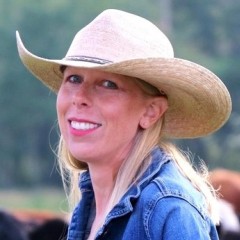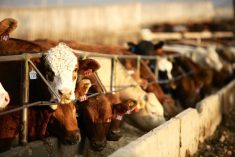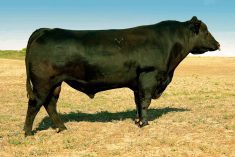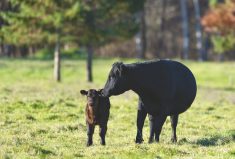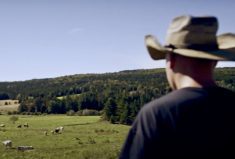Does the thought of working cattle bring to mind shouting, pushing unwilling cattle in directions they don’t want to go, and excessive prodding?
It doesn’t have to be that way.
The late Bud Williams started training producers and feedlot workers in low-stress handling methods three decades ago and today that work is carried on by other trainers, but also by Merck Animal Health.
A program called Creating Connections, developed in the U.S. and launched in Canada in 2016, builds on concepts promoted by Williams, said Amanda Elzinga-Pugh, a Merck account manager in Alberta.
Read Also

Mosquito-borne virus could be devastating to sheep breeding operations
Cache Valley virus, a mosquito-borne disease that infects small ruminants, could be a devastating hit to small operations.
“It’s very innovative,” said Elzinga-Pugh. “The program was designed around establishing confidence and gaining trust in cattle to get them to create better flow and decrease stress versus our traditional view of pushing cattle from behind and moving them that way.
“It’s more of a concept of leading and guiding cattle.”
This fits with the natural behaviour of cattle, which always want to go back to where they came from, always want to move in a half-circle around you, and always want to see their source of guidance.
“For example, if you’re emptying a smaller pen, instead of getting behind the animals in the pen, you try to pick the animals that are focusing in on you and try to get them to pull the rest of the cattle with them,” said Elzinga-Pugh.
Once the front end of the herd is moving, it has almost a magnet effect, pulling the rest of the herd along.
“It’s putting pressure in the right place rather than pushing them all from behind, using pressure and release, which will tend to pull the rest of the herd with them.”
The program refers to the producer as the “caregiver” to emphasize his or her stewardship role.
“It is just more than covering their basic needs — it’s covering their needs to make them as comfortable and stress free as possible,” she said.
There have been some studies that found low-stress handling results in healthier animals and lower incidence of disease. One of the techniques promoted by the program is acclimation — there are three videos alone (out of about two dozen at www.creatingconnections.info) on that practice.
Some of her feedlot clients are using these techniques and seeing results, said Elzinga-Pugh.
“Anecdotally we’ve had a lot of success stories coming out of this from guys whom we’ve worked with,” she said. “So then we start to get some uptake through word of mouth from the success stories from the guys who have tried it and have seen the benefits.”
One of the videos has time-lapse footage of the experience of a timid and slightly weaker — but perfectly healthy — steer at a feedlot. After its first three days at the feedlot, the steer is visibly sick.
The sickness wasn’t because of a viral infection or anything — the steer hadn’t drank any water for two days.
“That really resonated with me,” said Elzinga-Pugh. “You think they’re going to go drink, but they don’t necessarily. It’s our job as caregivers to try to make them more comfortable and confident in their surroundings so they will go drink and they will go eat.”
Acclimation also works for calves.
This concept is called imprinting when used with newborn foals, and it allows animals to get used to humans and makes them easier to train. For example, when it’s time to tag a calf, instead of going out there and jumping and mugging it, it’s recommended to catch the animal gently and then to wait until it calms down before putting on the tag.
“We talk about your first interaction with the calf is something that they could remember for the rest of their life,” said Elzinga-Pugh.
“The desensitizing the calf concept is based on trying to have a good, first positive interaction with that calf because it will make it a lot easier the second time.”
Elzinga-Pugh has applied some of the acclimation and desensitizing concepts on her cattle operation. She and her husband were curious about the recommendation to put cattle through the chute when it’s wide open, allowing them to just walk through. While some would argue it’s not worth the time and effort, they decided to try it.
“We brought the group of heifers in to process, opened up the chute and let the heifers walk through the handling system,” she said. “The second time we brought them in, they walked in like nothing because they had just been through it.”
Creating Connections covers different sectors (cow-calf, stocker, feedlot, and dairy) and online modules sequentially cover all aspects of handling cattle, including stockmanship, transportation, acclimation, worker safety, weaning, and heat stress management.
“There’s also a human safety component,” said Elzinga-Pugh. “We have new feedlots and farms that are getting new workers in or new workers who maybe aren’t familiar with cattle.
“Even for ourselves, (working cattle) can be dangerous. Anything we do to help bring that risk down is a good thing.”
The program’s website has free videos and material, but some of the online content requires a login, so she suggests getting in touch with your Merck rep to obtain access. The company also runs clinics in conjunction with organizations such as Saskatchewan’s Verified Beef Production Plus program. Merck donated a cattle-handling clinic for 20 people for a silent auction at the recent Alberta Beef Industry Conference.

